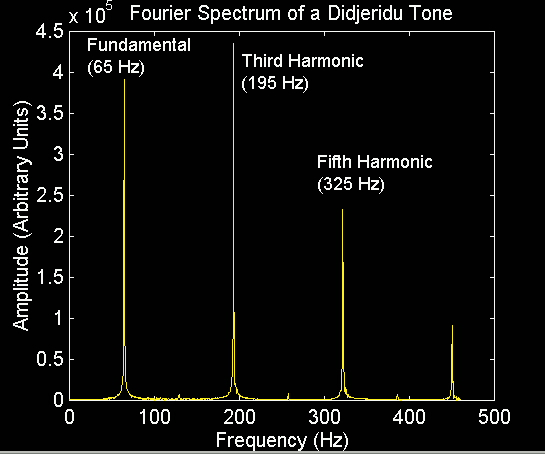The Physics of the Didjeridu
The didjeridu is a traditional Australian aboriginal instrument that consists of a long cylindrical tube, that is played by "blowing" in a similar way that a trumpet or other brass instrument is played. Didjeridu's are traditionally made of a hollowed out log, although there are a variety of novel, and more modern, materials used to create these instruments. There are lots of relevant sites on the Web dedicated to the history, social/religious significance of the instrument to the aborigines, as well as to descriptions of modern groups that are adapting the instrument to other styles of music. These sites also describe the construction of simple didjeridu's (PVC pipe is an inexpensive and fairly effective means of making a didjeridu) and how to play them. I became interested when Tim Karlik a student in my Physics of Music Course built a didjeridu as a final project let me keep the instrument at the end of the semester. From the physicists perspective the didjeridu is an excellent example of an instrument that depends on the standing waves of a cylindrical tube closed at one end. The simple theory of such a system, often taught in College Physics courses, predicts that the frequency spectrum will consist of only odd harmonics and that the fundamental or first harmonic frequency is related to the length of the hollow tube by the relation V/4L where V is the speed of sound (about 340 m/s) and L is the length of the tube.
To test this relation I digitally recorded myself playing a long sustained note with the didj and Fourier transformed the resulting time-domain signal to obtain the frequency spectrum shown in the figure below. The digital recording was made using a the sound card in my PC; the Fourier transform was performed by importing the sound file into MATLAB.

The length of the didjeridu tube was 131 cms which , using the formula above, predicts a fundamental frequency of 65 Hz. As you can judge by the figure this theoretical value is pretty much dead on with my experiment. You can barely see a small peak at about 130 Hz where the second harmonic should be and then a much stronger third harmonic. The trend continues with all even harmonics suppressed and only the odd harmonics present past the ninth harmonic.
I should mention that playing the didj (even badly!) is a strangely satisfying experience; at least for the player. I am not sure my efforts are always welcome by my wife or my dogs. The instrument is a drone instrument and only plays one note; color is added by changing the shape of the mouth to alter the relative strength of the harmonics much the same way we form vowel sounds. At least that's the explanation I have seen written down elsewhere. If I get some time, and if I learn to play a bit better, I might try to confirm this explanation by experiment. Or perhaps you might want to try! In any case you can hear my amateurish efforts at playing the didj in the accompanying sound file.
Since this file was created I have received a lot of interest from a variety of sources. First, I was interviewed by Roland Pease of the BBC World Service for a radio show on acoustics (click here to get more details and hear my interview). More recently I heard from James Gordon, a researcher from the University of Leeds, who is interested in the effect of the sound of low frequency didjeridu's on elephants! I only wish my mainstream research projects achieved the same attention-to-effort ratio.
Send me an email at wroberts@mtsu.edu
Contact Information
Dr. W. M. Robertson
MTSU Box X-116
Murfreesboro, TN 37132
Ph. (615) 898-5837